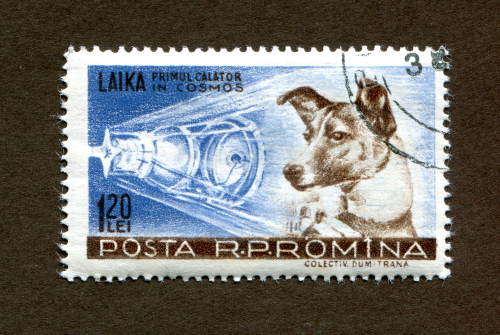
For better or worse, humans have sent a coffin’s worth of other animals into space. This veritable zoo of space travelers includes dogs, mice, fish, turtles, frogs, spiders and non-human primates.
But let’s start with some little guys – fruit flies.
The first animals in space: fruit flies
(Credit: Tomasz Klejdysz/Shutterstock)
Fruit flies were the first animals of any kind to leave the planet. Fruit flies make good experimental subjects because they are remarkably similar to humans genetic and cellular level.
They have been darlings of the research world for years, so they were an obvious choice for conducting biomedical research in space. However, the biggest advantage of fruit flies for off-planet exploration is that they don’t take up much space in an already small spacecraft.
Primates in space
Enos the chimpanzee, pictured wearing a spacesuit and reclining in his pilot’s couch while a handler holds his hands. It is being prepared for insertion into the Mercury-Atlas 5 capsule. December 18, 1961. (Credit: NASA, Public Domain, via Wikimedia Commons)
Fruit flies may be suitable for biomedical research, but mammals have been necessary when it comes to testing the physiological effects of spaceflight on humans. The first mammal sent into space was a rhesus monkey named Albert II.
The US Air Force launched the Albert II in 1949 after its predecessor, the Albert I, was launched in 1948. Unfortunately, the Albert I died before reaching space, and unfortunately, the Albert II also did not survive its mission – although it managed to make it to the record books too. He died after his capsule’s parachute failed to open on re-entry. Albert III, IV, V and VI (also known as Yorick) suffered a similar fate.
In 1958, a squirrel monkey named Gordo was launched into space on a Jupiter rocket. Gordo died in a fall when a flotation device failed. Rhesus monkeys Sam and Miss Sam (Sam’s wife) fared better. Both survived their missions to be returned to the training colony.
The early days of spaceflight were rough for the apes. It probably wasn’t any easier for the chimpanzees, but at least more of them survived the ordeal. In January 1961, a chimpanzee named Ham became the first chimpanzee in space. Its suborbital flight path was similar to that which Alan Shepard would soon take. Later that year, Enos, the first chimpanzee to orbit the Earth, returned from his flight in good condition. Successful primate missions to space paved the way for human spaceflight.
Read more: A brief history of chimpanzees in space
Russian dog in space
(Credit: Shan_shan/Shutterstock)
While the US sent monkeys into space, the Soviet Union preferred to send dogs. The most famous canine space traveler was Laika, although she was not the first dog in space. Desik and Gypsy, two dogs released by the Soviets in 1951, have that honor. Between 1951 and 1952, Soviet rockets carried nine dogs into space. Two dogs named Strelka and Belka, along with 40 mice, were aboard the launch of Sputnik 5 in 1960.
Chamomile, however, was the first animal of any kind to walk the Earth. Laika did not survive her journey, but that was no surprise. Then there was no way to get her back. She was expected to run out of oxygen after about ten days, but according to NASA’s account, she likely died after a day or two due to “thermal issues” when the ship’s ventilator failed.
The first cat in space
(Credit: Ron Fraser, CC BY 2.0 via Wikimedia Commons)
For reasons you might know if you share your home with a cat, cats are not often used in space programs. However, a graceful French cat named Félicette spent 15 minutes in space in 1963. The five-pound black-and-white cat returned safely to Earth. She was euthanized soon after her return so scientists could study how spaceflight affected her body. France has never sent another cat into space (nor has any other space program).
Read more: Details on space aging informs Health Research
Other animals sent into space
Once it became clear that humans could survive the harsh conditions of space travel, animals were used less as mannequins for test flights. Instead, they were forced to work in space labs as subjects in various scientific experiments. Many mice, frogs, spiders, fish, and even tiny tardigrades (not to mention bacteria) have spent time off-planet.
On his websiteNASA states:
“[T]these animals have taught scientists much more than could be learned without them. Without animal testing in the early days of the human space program, the Soviet and American programs could have suffered a great loss of human life. These animals have done a service to their countries that no man could or would do. They gave their lives and/or service in the name of technological advancement, paving the way for humanity’s many forays into space.”
Undoubtedly, these space programs have provided enormous benefits to both humans and other animals, but these animals did not volunteer. We couldn’t do it without them though; they deserve to be remembered.

